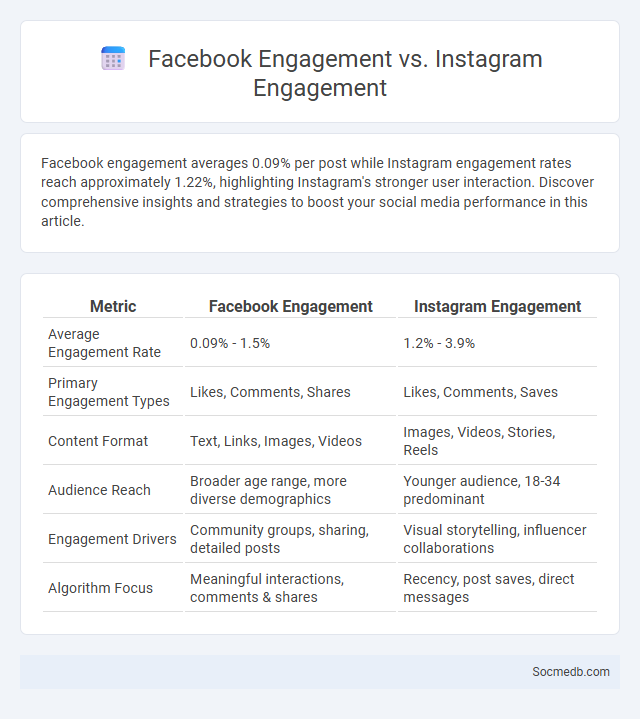
Photo illustration: Facebook Engagement vs Instagram Engagement
Facebook engagement averages 0.09% per post while Instagram engagement rates reach approximately 1.22%, highlighting Instagram's stronger user interaction. Discover comprehensive insights and strategies to boost your social media performance in this article.
Table of Comparison
| Metric | Facebook Engagement | Instagram Engagement |
|---|---|---|
| Average Engagement Rate | 0.09% - 1.5% | 1.2% - 3.9% |
| Primary Engagement Types | Likes, Comments, Shares | Likes, Comments, Saves |
| Content Format | Text, Links, Images, Videos | Images, Videos, Stories, Reels |
| Audience Reach | Broader age range, more diverse demographics | Younger audience, 18-34 predominant |
| Engagement Drivers | Community groups, sharing, detailed posts | Visual storytelling, influencer collaborations |
| Algorithm Focus | Meaningful interactions, comments & shares | Recency, post saves, direct messages |
Understanding Engagement: Definition and Importance
Understanding engagement on social media involves measuring interactions such as likes, comments, shares, and clicks that indicate how users connect with your content. High engagement rates signal meaningful connections with your audience, boosting visibility and fostering community growth. Your success on social platforms depends on consistently tracking and optimizing these engagement metrics to enhance brand loyalty and reach.
Facebook Engagement: Key Metrics and Features
Facebook engagement metrics include likes, comments, shares, and post clicks, which indicate the level of user interaction and content relevance. Features such as reactions (love, wow, angry), video views, and story interactions provide deeper insights into audience sentiment and behavior. Monitoring these metrics helps optimize content strategies, boost organic reach, and improve overall page performance on the Facebook platform.
Instagram Engagement: Key Metrics and Features
Instagram engagement centers on key metrics such as likes, comments, shares, and saves, which collectively measure user interaction and content relevance. Features like Stories, Reels, and interactive stickers enhance engagement by encouraging real-time participation and deeper audience connection. Analyzing metrics like engagement rate, reach, and profile visits provides valuable insights for optimizing content strategy and boosting brand presence on the platform.
Differences Between Facebook and Instagram Engagement
Facebook engagement often emphasizes detailed content through text posts, links, and events, attracting a broader demographic with diverse interaction types such as comments, shares, and reactions. Instagram engagement thrives on visual storytelling via photos, stories, and reels, with higher user interaction rates fueled by likes, direct messages, and hashtag-driven discovery. The algorithmic focus on real-time and visually appealing content on Instagram contrasts Facebook's multifaceted content approach, shaping distinct user behaviors and engagement metrics on each platform.
Content Types: What Works Best on Each Platform
On Instagram, high-quality images and short Reels gain the most engagement due to the platform's visual focus and algorithm preference. Twitter excels with concise text updates, breaking news, and trending hashtags that encourage real-time interaction and sharing. LinkedIn is optimal for professional articles, industry insights, and thoughtful commentary that establish authority and foster networking among business professionals.
User Demographics and Behavior Analysis
User demographics on social media platforms reveal distinct patterns in age, gender, and geographic location, influencing content preferences and engagement rates. Behavioral analysis highlights trends such as peak activity times, interaction types like sharing or commenting, and platform-specific habits that drive user retention. Understanding these demographic and behavioral insights enables targeted marketing strategies and optimized content delivery for brands and influencers.
Algorithm Impact on Engagement Rates
Social media algorithms prioritize content based on user interactions, significantly affecting engagement rates by determining which posts appear in your feed. These algorithms analyze factors like likes, shares, comments, and watch time to predict content relevancy, boosting visibility for posts that generate higher engagement. Understanding this dynamic allows you to tailor your content strategy to increase reach and foster stronger connections with your audience.
Effective Strategies for Boosting Engagement
Creating compelling content tailored to the target audience increases social media engagement by capturing attention and encouraging interactions. Utilizing interactive features such as polls, quizzes, and live videos fosters real-time communication and community building. Consistent posting schedules combined with data-driven analysis of peak activity times maximize reach and user participation across platforms.
Measuring Engagement: Tools and Best Practices
Measuring social media engagement relies on tools like Google Analytics, Hootsuite, and Sprout Social, which track metrics such as likes, shares, comments, and click-through rates. Best practices involve setting clear objectives, analyzing audience demographics, and monitoring sentiment to gauge the effectiveness of content strategies. Regularly reviewing engagement data helps optimize campaigns to increase brand reach and customer interaction.
Choosing the Right Platform for Your Engagement Goals
Selecting the ideal social media platform depends on your target audience demographics and content style, with Instagram and TikTok excelling for visual engagement and LinkedIn catering to professional networks. Understanding platform-specific algorithms and features enhances content visibility and interaction rates, directly impacting engagement goals. Tailoring your strategy to leverage these unique platform dynamics maximizes reach and conversion potential.
 socmedb.com
socmedb.com